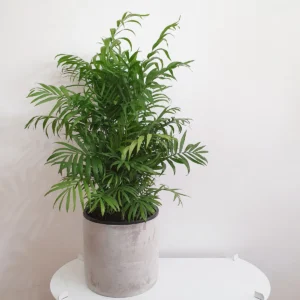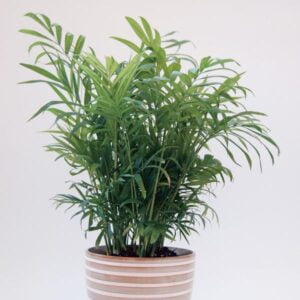Introduction
The Indoor Plant Parlor Palm, scientifically named Chamaedorea elegans, is more than just a plant; it’s a statement piece that elevates any room’s ambience. Native to the rainforests of Mexico and Guatemala, this petite palm has swiftly gained popularity among indoor plant enthusiasts for its adaptability and aesthetic appeal. In the following review, we’ll delve deep into the care and concerns associated with this elegant plant, ensuring that even beginners can foster a flourishing palm.
The Parlor Palm (Chamaedorea elegans) indoor plant:
| Specification | Details |
|---|---|
| Common Names | Parlor Palm, Neanthe Bella Palm, Dwarf Mountain Palm |
| Botanical Name | Chamaedorea elegans |
| Family | Arecaceae (Palm family) |
| Plant Type | Evergreen perennial |
| Mature Size | Up to 4 feet indoors; it can reach 6-8 feet in its natural habitat |
| Sun Exposure | Bright, indirect light. Can tolerate low light conditions but may grow more slowly. |
| Soil Type | Well-draining potting mix. A blend of peat, pine bark, and sand is ideal. |
| Soil pH | Slightly acidic to neutral (6.1 to 7.5) |
| Bloom Time | Late winter to early spring. Blooming is rare indoors. |
| Flower Color | Yellow (though flowers are inconspicuous and rarely seen indoors) |
| Hardiness Zones | 10-12. Primarily grown indoors in most zones, but can be outdoor in zones 10-12 |
| Native Area | Rainforests of Southern Mexico and Guatemala |
The Indoor Plant Parlor Palm’s key specifications. It’s a beautiful and adaptable plant, making it a favorite choice for many indoor plant enthusiasts. By adhering to its specific care requirements, you can ensure a healthy, thriving palm for years to come.
Plant Care: Fostering a Flourishing Indoor Plant Parlor Palm
Caring for the Parlor Palm isn’t an arduous task; in fact, its undemanding nature is a significant reason for its widespread acclaim. However, knowing specific requirements will ensure that your palm doesn’t just survive, but thrives. From its light preferences to ideal soil composition, we’ve got you covered.
Light: Illuminating Success
The Parlor Palm isn’t too fussy about light. It gracefully adapts to low light conditions, making it ideal for homes that aren’t sun-drenched. However, for optimal growth, bright, indirect light is its best companion. Avoid exposing it to direct sunlight for prolonged periods, as it may scorch the delicate fronds.
Soil: Setting Down Roots
For a palm that feels right at home, well-draining soil is essential. A mix that contains peat, pine bark, and sand, in equal parts, works wonders. The light and airy consistency of this blend ensures that the roots remain healthy, devoid of rot.
Water: Quenching Thirst the Right Way
Watering the Parlor Palm requires a delicate balance. Overwatering can lead to root rot, while under-watering may cause its fronds to dry out. It’s best to wait until the top inch of soil feels dry before watering thoroughly. Using filtered or distilled water can prevent the risk of fluoride toxicity.
Temperature and Humidity: Creating an Ideal Climate
This tropical gem thrives in temperatures ranging from 65°F to 80°F (18°C to 27°C). Avoid exposing it to temperatures below 50°F (10°C). Given its rainforest roots, it adores high humidity. If your home is dry, consider placing it on a tray filled with pebbles and water or investing in a humidifier.
Fertilizer: Nourishing for Growth
While the Parlor Palm isn’t a heavy feeder, a bit of fertilization can give it a boost. During its growing season, from spring to early fall, apply a balanced liquid fertilizer every 4-6 weeks. Ensure that it’s diluted to half its recommended strength to avoid over-fertilization.
Pruning: Refining Elegance
Pruning isn’t just about aesthetics; it promotes healthier growth. Regularly inspect your palm and remove any yellow or brown fronds by cutting them off at the base. This ensures that the plant can focus its energy on producing lush, green fronds.
Overwintering: Ensuring Survival through Cold
Even though the Parlor Palm is an indoor plant, some regions may experience chilly indoor temperatures during winters. In such cases, ensure that your palm is placed in a location free from drafts. While it’s dormant during this season, water it less frequently.
Propagating Plant: Multiplying Beauty
For those looking to multiply the beauty of the Parlor Palm, propagation is relatively straightforward. The most effective method is through seeds. Plant fresh seeds in a well-draining mix, keep them moist, and with patience, new seedlings will emerge.
Quickly Declining: Signs and Solutions
It’s crucial to regularly monitor your palm for signs of distress. Yellow fronds may indicate overwatering, while brown tips could be a sign of low humidity. Adjust care routines accordingly. Spider mites and scale are common pests; a gentle wipe with a damp cloth or neem oil application can keep these pests at bay.
A Glimpse into the Future: Next Steps for Your Indoor Plant Parlor Palm
Having armed you with all the knowledge necessary, it’s evident that the Parlor Palm’s success lies in understanding its needs and making minor adjustments. With your dedicated care, this plant will not only survive but will thrive, becoming a timeless piece in your home’s decor.
Types of Indoor Plant Parlor Palm Varieties
Parlor Palms, or Chamaedorea elegans, predominantly belong to one main type. However, the genus Chamaedorea consists of over 100 species. Among them, a few are commonly cultivated:
- Chamaedorea metallica: This variety has leaves with a metallic sheen, thus the name. It’s particularly sought after for its unique appearance.
- Chamaedorea seifrizii: Also known as the Bamboo Palm, this species has multiple stems and can grow taller than the classic Parlor Palm.
- Chamaedorea erumpens: Often mistaken for seifrizii, this variety has a denser appearance and is perfect for those looking for a bushier plant.
Common Pests & Plant Diseases: Recognition and Resolution
Despite the Parlor Palm’s resilience, it’s not immune to pests and diseases:
- Spider Mites: Tiny arachnids that suck the sap from the plant. Solution: Regularly mist your palm to increase humidity and deter mites. If infested, use insecticidal soap or neem oil.
- Scale: Small insects that attach to the plant surface and feed on its sap. Solution: Remove manually with a soft cloth and treat with neem oil.
- Root Rot: Usually caused by overwatering. Affected plants will have brown, mushy roots. Solution: Repot the plant, trimming away damaged roots, and ensure proper watering routine.
- Leaf Spot: Caused by fungal infections, it manifests as brown or black spots on the leaves. Solution: Remove affected leaves and ensure proper air circulation around the plant.
How to Get the Indoor Plant Parlor Palm to Bloom
Blooming indoors is rare for the Parlor Palm, but with optimum care, it’s possible:
- Mature Plant: Young Parlor Palms won’t flower. Ensure your plant is mature, usually around 4-6 years old.
- Optimal Lighting: While the palm tolerates low light, providing bright, indirect light can encourage blooming.
- Consistent Care: Ensure the palm receives consistent care in terms of watering, humidity, and feeding.
- Seasonal Variation: Mimic its natural habitat by providing cooler temperatures during the winter, followed by a warmer, humid growing season.
 Common Problems with the Indoor Plant Parlor Palm and Their Solutions
Common Problems with the Indoor Plant Parlor Palm and Their Solutions
- Yellowing Leaves: Often due to overwatering. Solution: Allow the top inch of soil to dry between waterings.
- Brown Leaf Tips: Caused by low humidity or fluoride in tap water. Solution: Increase humidity and use filtered or distilled water.
- Slow Growth: Parlor Palms are naturally slow growers, but insufficient light or nutrients can further impede growth. Solution: Move to a brighter location and ensure regular feeding during the growing season.
- Drooping Fronds: Often due to underwatering or root rot. Solution: Check the soil moisture and root health. Adjust watering routine or repot if necessary.
By recognizing the potential problems and acting promptly, it’s possible to maintain a healthy and thriving Parlor Palm. This plant, with its lush fronds and adaptive nature, can remain a centerpiece in homes for years to come, given the right care and attention.
With its graceful presence and relatively easy care, the Parlor Palm is an excellent addition to any indoor space. From creating a tropical oasis to elevating the aesthetics of a room, this palm is a versatile choice for both novice and seasoned plant enthusiasts. Armed with this comprehensive guide, one can confidently foster a flourishing Parlor Palm.
Frequently Asked Questions
Decode the magic of gardens with our guide to Landscaping Styles Frequently Asked Questions.
- No, the Parlor Palm is pet-friendly and non-toxic to both cats and dogs.
- With proper care, it can reach heights of up to 4 feet indoors.
- Brown tips can be a sign of low humidity or tap water with high fluoride. Adjust humidity levels and use filtered water.
- Repotting every 2-3 years is ideal, especially when the roots outgrow the pot.
Recent Posts
- Modern Mural Ideas Transforming Walls into Artworks
- Thematic Table Decor Dressing Your Table for Special Occasions
- Festive Lighting Ideas Brightening Your Home for the Holidays
- Biodegradable Decor Materials Choosing Earth-Friendly Options
- Personalized Space Decor Making Your Home Uniquely Yours
- New Year’s Eve Decor Ringing in the New Year in Style
- Transforming Junk into Decor Upcycling at Its Best
- Second-Life Decor Objects Giving Old Items New Purpose
- Unique Decoration Crafting Standout Ideas for Your Home
- Environmentally Friendly Styling Decor with a Conscience











